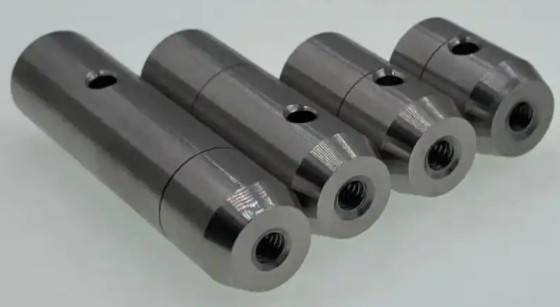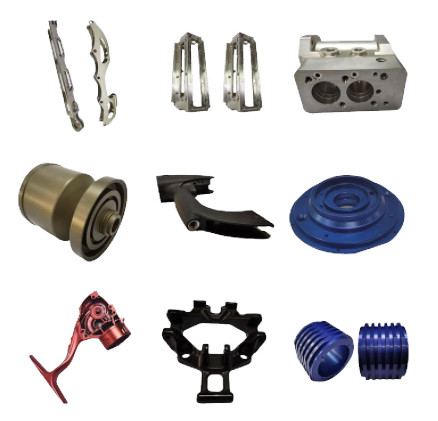The positioning block discussed in this article is a small component with dimensions of 7.5 mm × 4.5 mm × 5 mm, as shown in Figure 1. It is made from stainless steel, a material known for its high hardness and toughness, which classifies it as a difficult-to-machine material. Traditional machining methods involve cutting a single block of material and processing it using clamping techniques. Due to the small size of the part, clamping often leads to deformation during machining, resulting in dimensional inaccuracies. Additionally, with a batch size exceeding 10,000 units per production cycle, single-piece machining requires frequent clamping, leading to low efficiency and extended processing times.
Challenges in Traditional Single-Piece Machining
Single-piece machining of small positioning blocks presents several limitations. The primary issue is the difficulty in securely clamping such small components without causing deformation. The high hardness of stainless steel exacerbates this problem, as the material resists cutting forces, increasing the likelihood of dimensional errors. Furthermore, the repetitive clamping process for each part in a batch of over 10,000 units significantly increases labor intensity and processing time. For instance, machining a single positioning block using traditional methods takes approximately 25 minutes, which is inefficient for large-scale production. These constraints necessitate a more effective approach to improve both quality and productivity.

Adopting a Combined Arrangement Machining Method
To address the limitations of single-piece machining, a combined arrangement method was developed. Instead of processing individual parts, a stainless steel plate measuring 220 mm × 20 mm × 6 mm is used as the raw material. This plate is arranged to accommodate 28 positioning blocks in a single setup, as illustrated in Figure 2. The machining process employs wire electrical discharge machining (WEDM) for material separation, ensuring precise control over the thickness of each part. This method reduces the need for frequent clamping, minimizes deformation, and enhances overall processing efficiency.
The combined arrangement approach significantly reduces operator workload by streamlining the setup process. By machining 28 parts simultaneously, the method eliminates the need for individual clamping, which not only saves time but also reduces the risk of quality issues caused by improper clamping. Additionally, wire cutting ensures consistent part thickness, addressing the deformation issues associated with traditional machining of the part’s reverse side.
Process Route and Equipment Specifications
The revised machining process follows the principle of operation concentration, where multiple operations are performed in a single setup to maximize efficiency. The process route for the combined arrangement method is as follows:
- Material Preparation: A stainless steel plate (220 mm × 20 mm × 6 mm) is cut to size.
- Rough and Finish Milling: The external contours and internal grooves of the 28 positioning blocks are machined on the plate.
- Wire Cutting: WEDM is used to separate the individual parts, ensuring precise thickness control.
- Deburring: A manual finishing step removes burrs to meet final quality requirements.
The machining is performed on a V20i vertical machining center, selected for its compatibility with the process requirements. The equipment specifications are detailed in the table below:
| Parameter | Specification |
|---|---|
| X-Axis Travel | 500 mm |
| Y-Axis Travel | 450 mm |
| Z-Axis Travel | 500 mm |
| Worktable Size | 600 mm × 500 mm |
| Positioning Accuracy | 0.005 mm |
| Repeat Positioning Accuracy | 0.01 mm |
| Tool Magazine Capacity | 20 tools |
| Tool Change Method | Robotic arm |
The V20i machining center supports the entire process, including rough milling, finish milling, and drilling, with a tool magazine capacity of 20 tools, sufficient for the required operations (up to 16 tools). The robotic arm tool change system ensures efficient transitions between operations, and the machine’s high positioning accuracy (0.005 mm) guarantees dimensional precision for the small parts.
Validation of Processing Outcomes
The combined arrangement method was validated through a production run of 15,000 positioning blocks. The results demonstrated significant improvements in both quality and efficiency. The pass rate for the machined parts reached 99%, indicating high consistency and reliability. The processing time for a batch of 28 parts was reduced to 135 minutes, compared to 25 minutes per part in the traditional method. This translates to an average processing time of approximately 4.82 minutes per part, a substantial improvement over the 25-minute single-piece process.
The quality improvements are attributed to the elimination of frequent clamping, which reduces deformation risks, and the precision of wire cutting, which ensures uniform thickness. The machining outcomes are illustrated in Figure 3, showing consistent part dimensions and surface quality. The method’s ability to process multiple parts in a single setup also reduces operator fatigue and minimizes errors associated with repetitive setups.
Quantitative Comparison of Processing Methods
To highlight the efficiency gains, the following table compares the traditional single-piece machining method with the combined arrangement method:
| Metric | Single-Piece Machining | Combined Arrangement |
|---|---|---|
| Parts per Setup | 1 | 28 |
| Processing Time per Part (min) | 25 | 4.82 (135 min / 28 parts) |
| Pass Rate | Not specified | 99% |
| Clamping Frequency | High (per part) | Low (per 28 parts) |
| Deformation Risk | High | Low |
The data clearly shows that the combined arrangement method offers superior efficiency and quality. The reduction in processing time per part and the high pass rate demonstrate the method’s suitability for large-scale production of small parts.
Applicability to Other Small Parts
The combined arrangement method is not limited to positioning blocks but can be applied to other small, high-precision components with similar characteristics. Parts made from difficult-to-machine materials, such as stainless steel or titanium, benefit from reduced clamping and precise material separation techniques like wire cutting. The method is particularly effective for batch sizes exceeding 10,000 units, where the time savings from fewer setups become significant. Manufacturers can adapt the plate size and arrangement pattern to accommodate different part geometries, provided the machining center has sufficient travel and tool capacity.

Cost Reduction and Scalability
The combined arrangement method contributes to cost reduction in several ways. First, the reduced processing time per part lowers labor and machine operating costs. Second, the high pass rate (99%) minimizes material waste and rework expenses. Third, the use of existing equipment, such as the V20i machining center, eliminates the need for specialized machinery, further reducing capital expenditure. The method’s scalability is evident in its ability to handle large batch sizes efficiently, making it suitable for industries requiring high-volume production of small components, such as aerospace, automotive, and electronics.
Conclusion
The combined arrangement machining method, utilizing a single steel plate to process 28 positioning blocks simultaneously, effectively addresses the limitations of traditional single-piece machining. By reducing clamping frequency, minimizing deformation, and leveraging wire cutting for precise material separation, the method achieves a 99% pass rate and significantly improves processing efficiency. The average processing time per part drops from 25 minutes to approximately 4.82 minutes, enabling high-volume production with lower costs. This approach is adaptable to other small, high-precision parts and offers a scalable, cost-effective solution for manufacturers. The use of standard equipment, such as the V20i machining center, ensures accessibility, making this method a practical choice for industries requiring efficient batch processing.
